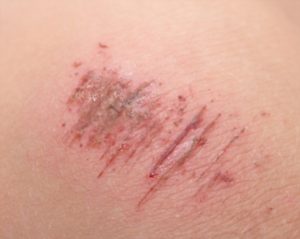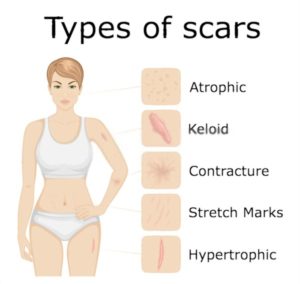 There is such a well-known expression “the scars adorn a man”, from which a kind of pirate immediately arises before the eyes, on whose body there are many marks indicating his stormy life. But now not only women, but also many men prefer to have smooth, unscarred skin.
There is such a well-known expression “the scars adorn a man”, from which a kind of pirate immediately arises before the eyes, on whose body there are many marks indicating his stormy life. But now not only women, but also many men prefer to have smooth, unscarred skin.
Not everyone decides on the surgical methods of influencing the scar tissue, so there is a search for alternative painless ways to solve this problem. Our task is to help, if not get rid of scars, then at least make them look less visible with the help of natural and essential oils. Anyone doubts that this works?
Where do scars come from?
 It all starts out the same. He hit a nail, cut himself with a knife, got burned, hit something sharp – the result is the same: a skin injury.
It all starts out the same. He hit a nail, cut himself with a knife, got burned, hit something sharp – the result is the same: a skin injury.
In response to this, the body starts the process of emergency skin regeneration. The following happens: first, blood flows from the wound, which gradually thickens. Its upper part hardens, a crust forms, under which active work begins, fibroblast cells quickly begin to replace the damaged tissue with a new covering. Basically, scar tissue is made up of the same proteins and collagen as normal skin.
Why does it look different?
In the scar tissue there are no hair follicles or sweat glands, it is coarser and thicker and differs in colour from normal skin. British scientists in 1998 explained this phenomenon. They found that in normal skin, collagen fibers are intertwined, and in scar tissue, these fibers are parallel to each other. This is what gives the scar a completely different look and makes it stand out against the background of normal skin.
 Why does this happen?
Why does this happen?
Obviously, it takes a long time for the collagen fibers to interweave, and with an open wound there is a high risk of infection, so the body quickly creates a simpler option – scar tissue. Naturally, the larger the damage, the more scar tissue is formed and the more visible the scar will be.
Scars have different types: postoperative, keloid scars, post-burn scars, stretch marks (striae), acne scars.
By itself, scar tissue is not able to change its structure and it will never turn into normal skin. If the scars are large, professional medical procedures are available such as:
- Chemical peels, in which highly concentrated acids are used, which dissolve the top layer of the scar, and new skin gradually forms under it, which requires special care and a long recovery period
- Dermabrasion, in which the top layer of the skin is removed using a cutter (a special device with a rotating nozzle). The procedure is quite traumatic and the skin from which the top layer was removed requires long-term rehabilitation.
- Injections for various purposes. Depending on the type of scar, fillers based on collagen, hyaluronic acid, fat or other substances are injected. These substances are gradually removed from the body, and these injections must be repeated after six months or a year. There are injections with absorbable action using corticosteroids, interferons. Their duration is determined by the cosmetologist.
- Surgical intervention. This is an extreme method of removing scar tissue, which is used when other methods do not work and the scar is a noticeable cosmetic defect. This also includes plastic surgery, in which a skin graft is transplanted from the patient’s healthy skin onto the damaged one.
 Treatment with natural oils
Treatment with natural oils
For small scars, you can try using natural and essential oils containing substances that soften the damaged layer of the skin and partially smooth the skin surface, as a result of which the scar becomes less visible. The time of scar tissue formation is approximately six months to a year. Cosmetologists consider this time to be the most appropriate time for effective exposure. The main goal in the fight against scars is to soften the skin, improve blood circulation, and accelerate cell regeneration. The result of using oils will depend on the age of the scar, the reason for its appearance and its size.
The most suitable natural oils for treating scar tissue are jojoba oil and sweet almond oil. But we shouldn’t forget black seed oil which, due to its unique properties, perfectly copes with skin diseases, protects wounds from infection and accelerates healing.
Jojoba oil contains a natural protein that resembles collagen in properties. Thanks to the smallest molecular size, the protein penetrates into the deep layers of the epidermis and enhances the production of collagen and elastin. Jojoba oil stimulates skin regeneration and helps fight scars and stretch marks on the body, as well as preventing the appearance of wrinkles. It contains high amounts of vitamin E, a natural antioxidant that fights free radicals, preventing premature skin ageing and neutralising the harmful effects of toxins on the skin
Sweet almond oil is high in fatty acids, vitamin E and antioxidants,  and is used to treat many skin problems such as acne, eczema, psoriasis. This oil is light and non-greasy and improves the softness and elasticity of the skin, making it a suitable oil for the treatment of scar tissue.
and is used to treat many skin problems such as acne, eczema, psoriasis. This oil is light and non-greasy and improves the softness and elasticity of the skin, making it a suitable oil for the treatment of scar tissue.
Black seed oil contains more than 100 types of beneficial nutrients that have a healing effect on all organs of the body, including the largest organ – our skin. It helps to heal wounds, and has a bactericidal, antimicrobial and haemostatic effect.
To enhance the regenerating effect on scar tissue, it is recommended to add some essential oils to the base oil. Oil blends are always more effective than mono oils. Here is a list of the most beneficial essential oils for treating scars:
Tea tree oil – is a powerful anti-inflammatory agent, has disinfecting properties, it is often used instead of iodine. When using it, the skin regenerates, the epidermis is restored. The oil can be applied neat to scar tissue.
 Rosemary oil – enhances cell exchange, accelerates skin regeneration. Tones and nourishes the epidermis, removes acne and subsequent scarring. When used, the skin becomes soft, smooth and healthy. Helps even with old scars.
Rosemary oil – enhances cell exchange, accelerates skin regeneration. Tones and nourishes the epidermis, removes acne and subsequent scarring. When used, the skin becomes soft, smooth and healthy. Helps even with old scars.
Rose oil – has an anti-inflammatory effect, promotes skin rejuvenation. It is often used to eliminate the effects of acne, eczema, dermatitis.
Lavender oil – copes well with a scar after a burn, especially fresh scarring.
Myrrh oil – suitable for fresh scar treatment after the bleeding has stopped. Treat within a few days as this will help accelerate skin regeneration. 
Lemon oil – helps to brighten the scar skin.
Frankincense oil – works best for recent scars. Helps heal and form less visible scars. It can be used alone or mixed with other oils.
These oils can be mixed together to enhance the effect.
When treating old scars, knead and pinch the skin to increase blood flow. Massage with oils is extremely important, it helps to soften the fibers of the scar tissue and restore blood circulation. But you must be patient as this is a long process. The earlier treatment is started, the higher the likelihood of fully-fledged skin formation where scar tissue usually forms.

